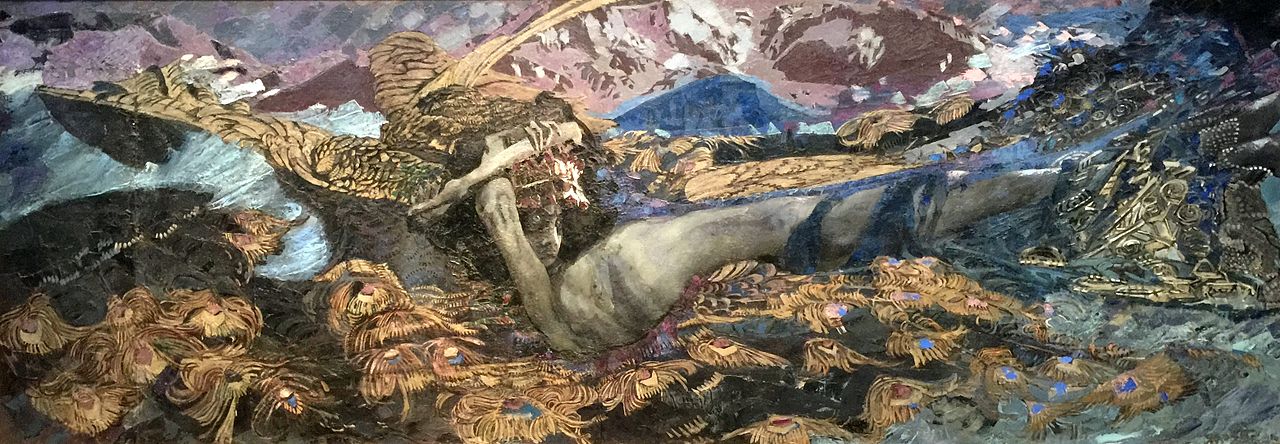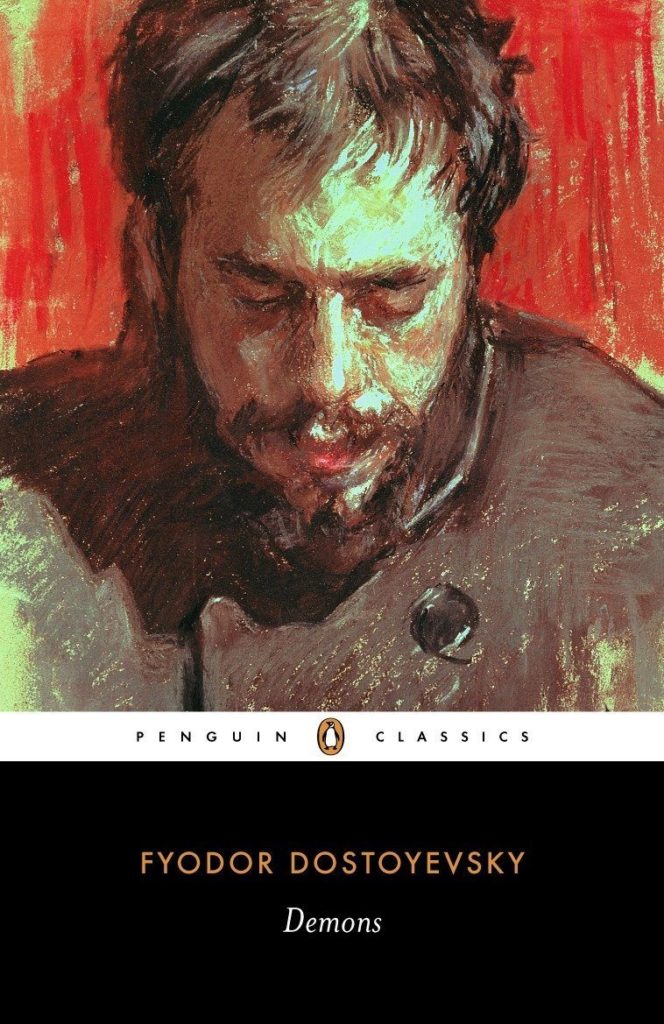In 1872, Dostoevsky published his novel, The Demons [Бесы]. It demonstrated in a microcosm, the insanity that lay within the revolutionary movements of 19th century Russia. That insanity broke upon the world in 1917 and has remained present with us, in one form or another, ever since.
The madness that he describes takes place in a small town, away from the great capitals of Russia. It involves a relatively small cast of characters (at least for a Russian novel and revolution). There is love and intrigue. But mostly there is murder and mayhem. For the only revolutionary who succeeds is the one who fears nothing himself but creates and feeds on the fear of others.
It is interesting that great theories of economics and social justice do not form a part of this novel. Dostoevsky was no stranger to Russia’s radical movements and their political and economic theories: he spent a number of years in prison under the Tsar for having participated in one such group.
But he does not make the theory out to be of much importance. He rightly recognized that the spirit of revolution is not about a struggle for a glorious future. Revolution is about the destruction of the present and the will to power. Hitler’s rise to power and Lenin’s rise to power both belong to differing ideologies. What they share in common are lies and murder.
Dostoevsky’s revolutionary sees the world as teetering on chaos. The old order is a roadblock, an encumbrance that stands in the way of progress and the forces of renewal. Every convention, every custom and practice of tradition is the enemy. The revolutionary has to be prepared to sweep everything aside for the sake of his cause.
In Dostoevsky’s Russia, the Church was a primary conserving force. Its Orthodox practice was a shrine to Tradition and custom. Every aspect of life moved in obedience to the seasons of the Church. It is thus not surprising that the Church, God and the Christian view of the world were the primary targets of his drama.
But the title of Dostoevsky’s novel is even more to the point. Though he does not say so, the actors in the small “revolution” in the provinces, are only pawns. There is a larger game afoot, and that game is revealed in the title of the novel.
The work of the demons is not an ancient conspiracy, a carefully-planned work that ultimately results in the enthronement of the anti-Christ. Demons do not seem to be driven towards the construction of great empires – that activity is particularly human.
The work of the demons (both in the novel and in the real world) is the work of destruction. Existence is the gift of God. All that we know as existing is His gift. Its order, laws, even “reasonableness,” are all reflective of God’s creative work. Non-existence, non-being is the drive of the wicked ones.
Non-existence is not something that can be achieved by created beings, for existence is the gift of God and He alone sustains all things. Thus, the work of those in rebellion is to move things “towards” non-being. Lies, murder, destruction, disarray, deception, and the like are hallmarks of their work.
The demons are not the builders of civilizations, even civilizations that seem to have evil purposes. They corrupt and distort. The farcical “opera” that was the Nazi regime was a demonic attempt at civilization, a mimicry of the true thing.
Its delusional aspects seem so obvious now that people can only wonder how anyone ever took seriously its grand productions and Wagnerian pretensions (the delusions of our own time should be considered as well). The destructive character of that regime began to manifest itself quite early. In almost every effort, its constructions were distortions, an anti-civilization.
Where do the demons lurk in our own time? Look to the places of chaos and destruction, where order is slipping away and violence triumphs. Take note of despair and mayhem, any place where the drive towards non-existence has taken hold. Occasionally these forces manifest themselves in larger eruptions.
The bizarre extremism within radical Islam has all of the hallmarks of the demonic. It is a form of madness, of chaos, unleashed. Other extremes seem bent on the destruction of traditional ideas and norms that have existed for millennia.
The Orthodox resistance to iconoclasm recognizes the true nature of this urge to destruction. For the discussion about icons has never been limited to quiet theological thoughts about the nature of images. Iconoclasm is not a theological position, it is what its Greek name says, “Smashing.”
The smashers in the modern world have multiplied. The revolution of 1917 initially swelled their ranks. Films of icon burnings and Church explosions were only the most visible expressions. The smashing of human beings, images of God, were among the most brutal in all of history.
We see as well the sad cases of individual iconoclasm. The mass murders in schools, theaters, shopping malls (which sometimes seem to occur on a weekly basis) represent the demonic collapse within a single person. The wanton destruction of strangers, murder for the sake of murder, reveals a frightening drive towards non-existence. Of course, such events involve mental illness and other social problems, all of which are exploited by the demons of our time.
But more to the point for readers of this article is the unraveling of existence within our own lives and souls. Solzhenitsyn famously said: “…the line separating good and evil passes not through states, nor between classes, nor between political parties either, but right through every human heart, and through all human hearts.”
In the existential/spiritual terms that I’ve used here, we must recognize that the forces of disintegration and entropy war within us with the forces of order and true being. And we must recognize that true being only occurs in relationship – for it is the gift of God and has its existence in its giftedness and in its self-offering in return.
This life of receiving and offering extends not only to God but to all persons and things around us. It is nothing other than love. The Scriptures tell us that God is love. We must also understand that love is the only true existence – all else is a distraction and a distortion, a movement towards non-being.
For the individual who can walk through an elementary school and blithely shoot teachers and children, the heart has grown cold – on the order of demonic coldness. But by the same token, we ourselves can walk through any number of crowded places, our hearts filled with judgment and envy, or worse still, nothing at all. The former is only a demonic sacrament of the latter.
The demons in Dostoevsky’s novel ended their melee in an orgy of violence – a short spree that came to nothing. He wrote of other such eruptions of madness. The student Raskolnikov murdered an old woman in the name of a bizarre Nietzschean will to power. Dmitri Karamazov was convicted of murdering his father, though he was only guilty of wanting to. But in both of these latter cases, the outcome was not destruction, but repentance – in prison. Imprisonment for these Dostoevskian heroes is the place of rebirth, just as it was for the author himself.
Repentance, in prison or not, is the only way forward from the nightmare of our present demons. It is love that has grown cold. What we see in our present world is not the result of mistaken political decisions or failures of diplomacy. It is as Solzhenitsyn said – a battle within the heart of every human being. It is there that the demons must be defeated.
Father Stephen Freeman is a priest of the Orthodox Church in America, serving as Rector of St. Anne Orthodox Church in Oak Ridge, Tennessee. He is also author of Everywhere Present and the Glory to God podcast series.
The photo shows, “The Demon Fallen,” by Mikhail Vrubel, painted in 1902.

